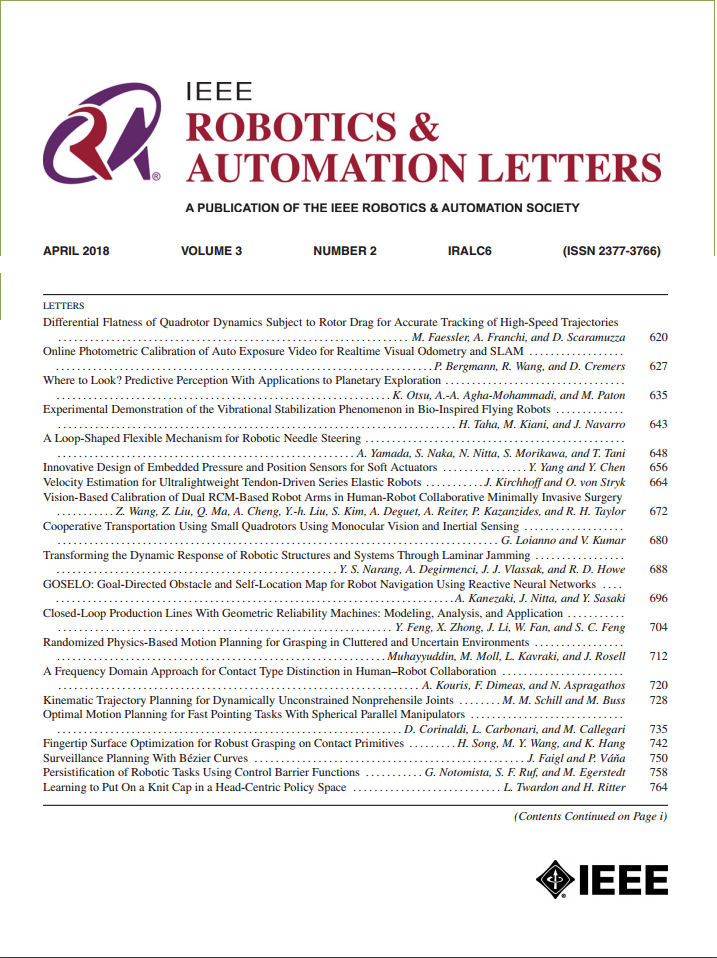基于截面变形的Cosserat杆软机器人建模
IF 5.3
2区 计算机科学
Q2 ROBOTICS
引用次数: 0
摘要
Cosserat棒模型被广泛用于仿真、设计和控制软机器人。Cosserat框架考虑了细长结构的弯曲、扭转、横向剪切和伸长率,并能正确处理3D中的大旋转和挠度,同时与使用有限元的全3D弹性模型相比,计算成本要低得多。然而,Cosserat模型并不总是适用于软机器人结构,因为它假设横截面永远不会改变大小或形状。在这封信中,我们扩展了标准的Cosserat杆模型,以包括横截面变形,同时保留了其简便性。我们在Cosserat模型中增加了额外的自由度,这些自由度参数化了横截面上的拉伸和剪切以及它们沿杆长变化的速率。然后,我们在状态变量(一个线性和一个非线性)上制定了几个可能的本构律,并将它们与标准的Cosserat能量表达式进行比较,以获得洞察力。我们进一步展示了流体驱动和肌腱驱动如何被纳入模型,并将扩展的Cosserat模型与三维非线性有限元模拟进行了比较,结果很一致。最后,我们演示了在机器人环境中使用该模型来控制蠕动蠕虫启发的软体机器人的路径跟随步态。本文章由计算机程序翻译,如有差异,请以英文原文为准。
Cosserat Rods With Cross-Sectional Deformation for Soft Robot Modeling
Cosserat rod models are widely used to simulate, design, and control soft robots. The Cosserat framework accounts for bending, torsion, transverse shear, and elongation of a long, slender structure and correctly handles large rotations and deflections in 3D, while being far less computationally expensive than full 3D elasticity models using finite elements. However, the Cosserat model is not always appropriate for soft robotic structures since it assumes the cross sections never change size or shape. In this letter, we extend the standard Cosserat rod model to include cross-sectional deformation while retaining much of its simplicity. We add to the Cosserat model additional degrees of freedom that parameterize stretch and shear in the cross-sectional plane and their rates of change along the rod length. We then formulate several possible constitutive laws on the state variables (one linear and one non-linear) and compare them to the standard Cosserat energy expressions to gain insight. We further show how fluidic actuation and tendon actuation can be incorporated into the model, and we compare the extended Cosserat models to 3D nonlinear finite-element simulations with good agreement. Finally, we demonstrate use of this model in a robotics context to control the path-following gait of a peristaltic worm-inspired soft robot.
求助全文
通过发布文献求助,成功后即可免费获取论文全文。
去求助
来源期刊

IEEE Robotics and Automation Letters
Computer Science-Computer Science Applications
CiteScore
9.60
自引率
15.40%
发文量
1428
期刊介绍:
The scope of this journal is to publish peer-reviewed articles that provide a timely and concise account of innovative research ideas and application results, reporting significant theoretical findings and application case studies in areas of robotics and automation.
 求助内容:
求助内容: 应助结果提醒方式:
应助结果提醒方式:


